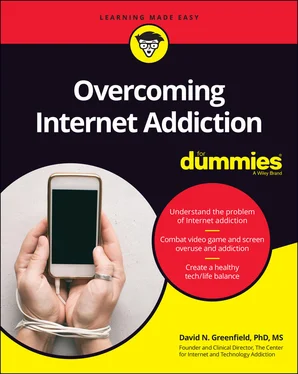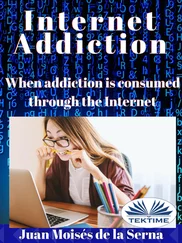According to the WHO, gaming disorder is a subcategory of addictive behavior and is defined in the 11th revision of the International Classification of Diseases (ICD-11) as a pattern of gaming behavior (“digital-gaming” or “video-gaming”) characterized by impaired control over gaming; increasing priority is given to gaming over other activities to the extent that gaming takes precedence over other interests and daily activities, and there is a continuation or escalation of gaming, despite the occurrence of negative life consequences.
For gaming disorder to be diagnosed, the behavior pattern must be of sufficient severity to result in significant impairment in personal, family, social, educational, occupational, or other important areas of functioning and would normally have been evident for at least 12 months.
Availability is like ease of access, but it speaks to the fact that Internet access is nearly always available, as smartphones, hardwired broadband home or office access, LAN, Wi-Fi, or access through your cell service makes the Internet nearly always available. More rural areas may be an exception to this unfettered access, but with satellite and fiber optics, this is also changing. In fact, many of us will soon rarely be without access to the Internet, which just increases the allure and temptation of checking that app or website, viewing that post, sending a text, or playing the latest version of your favorite game. It seems that there is no easy way to avoid easily accessing this digital drug.
 When an addictive behavior is easily accessible and available, it increases the likelihood of addictive use. It’s also important to remember that a big part of why addictive use of Internet technology is problematic is because of the amount of time it steals from our lives without our being aware of it.
When an addictive behavior is easily accessible and available, it increases the likelihood of addictive use. It’s also important to remember that a big part of why addictive use of Internet technology is problematic is because of the amount of time it steals from our lives without our being aware of it.
Talking about time distortion
Perhaps one of the most powerful drug-like effects of screen use is the time distortion that occurs online. One of the hallmarks of any substance or intoxicating behavior is that it can alter mood or consciousness, thus creating a time-distorting experience. In my 1999 study, I found that a large majority of users reported the time-distorting effect of the Internet. Perhaps you yourself have noticed losing track of time when you’re online? The immersive and dopamine rewarding experience of the Internet clearly impacts our perception of the passage of time.
THE FIRST LARGE-SCALE STUDY OF INTERNET ADDICTION — AND WHAT HAPPENED NEXT
I worked my way through 12 years of college and professional training as an electronics technician, and I always had an affinity for science and electronics, so computers and the Internet fit right in. I believe it was this coalescence between my interest in electronics, addiction medicine, and human sexual behavior that offered a perfect combination for my newly developing specialty in Internet and technology addiction.
In the earlier days of the Internet, I collaborated with a colleague, Dr. Alvin Cooper, on some articles and publications on the interaction between the Internet and sexual behavior. Dr. Cooper was an early pioneer in research on the addictive nature of the Internet as well as Internet sexuality. Around this time, I read a paper written by the late Dr. Kimberly Young, who published the results of a small pilot study comparing Internet addiction to pathological gambling (the medical diagnostic term for gambling addiction). In her study, she identified several factors that seemed to play a role in the addictive nature of the Internet. I was intrigued, and shortly after, I embarked on a partnership with ABC News to develop and publish the results of the first large-scale study on Internet addiction.
Research in psychiatry and behavioral science is an arduous process and involves attracting subjects to study, so we decided to develop a broad and statistically sound survey that would be posted online for people to complete and that would give us an idea of what they were doing and experiencing online. There are, of course, limitations to a self-selected and self-reported study, but it was a first step. So, in 1997 the study finally went up on the ABC News servers, and in less than two weeks, we had over 18,000 responses. Some subjects were thrown out, but even with these rejections, this was an unheard-of response and gave us thousands of lines of data to look at, thus beginning an entirely new subspecialty of behavioral addiction medicine for me. I often tell doctors and clinicians whom I train that my specialty sort of found me, as opposed to me choosing it.
It took months to analyze the data, which led to a journal publication and resulted in my 1999 book entitled Virtual Addiction. At the time of my research, only one book had been published on the subject and there was almost no research; today, there are hundreds of books on the subject, and you can find nearly a thousand research studies and clinical papers on it. In short, we know a lot more about the Internet than we did in the mid-1990s.
The result of my original research (which has since been supported) is that yes, the Internet and the portals through which we consume it are clearly addictive. It is well accepted that Internet addiction and video game addiction are legitimate diagnoses, which, in 2019, led the World Health Organization (WHO) to declare Gaming Disorder an official medical diagnosis to be included in its upcoming ICD-11 (International Classification of Diseases, 11th revision), which is the leading manual for all medical diagnoses used in healthcare.
 What time distortion tells us is that the Internet digital drug is powerful and can alter our perceptions. The reason for this appears to be, in part, that the Internet and screens hyper-focus our attention while interactively distracting us — while transmitting stimulating and intoxicating content at the same time. When you couple all of this with variable rewards, you can see how a person can become stuck online and get lost in cyberspace.
What time distortion tells us is that the Internet digital drug is powerful and can alter our perceptions. The reason for this appears to be, in part, that the Internet and screens hyper-focus our attention while interactively distracting us — while transmitting stimulating and intoxicating content at the same time. When you couple all of this with variable rewards, you can see how a person can become stuck online and get lost in cyberspace.
 Digital drug delivery is very similar to the way drugs are consumed and metabolized in our bodies. The shorter the time between introducing an intoxicating drug or behavior into our nervous system and subsequent intoxication, the more addictive that drug or behavior is. This is because our nervous system is very responsive to the brevity of time between stimulation and intoxication — in essence, this is classical conditioning. The shorter the time that passes between when you click and then see, find, or play something online that is desirable to you, the more addictive potential it has. This speed factor likely means there are potential negative implications to faster processor speeds and high-speed Internet access connections — in this sense, faster may not always be better.
Digital drug delivery is very similar to the way drugs are consumed and metabolized in our bodies. The shorter the time between introducing an intoxicating drug or behavior into our nervous system and subsequent intoxication, the more addictive that drug or behavior is. This is because our nervous system is very responsive to the brevity of time between stimulation and intoxication — in essence, this is classical conditioning. The shorter the time that passes between when you click and then see, find, or play something online that is desirable to you, the more addictive potential it has. This speed factor likely means there are potential negative implications to faster processor speeds and high-speed Internet access connections — in this sense, faster may not always be better.
Giving you the world online: The illusion of online productivity
The Internet seems to create an illusion of productivity. Perhaps this is in part because we use our screens so much for school and work (and during the COVID pandemic, even more so). The problem is that the Internet doesn’t actually increase productivity when you factor in all the wasted and unproductive time we spend on our screens. This is not to mention all the glitches, lost passwords, Internet outages, and other technical difficulties that we experience. There are estimates that 80 percent of the time we spend online is not for productive purposes, and much of the time we spend online is related to surfing or scrolling around, social media, pornography, video gaming, sports, shopping, or other intoxicating behaviors that devour time and attention without our being aware of it.
Читать дальше

 When an addictive behavior is easily accessible and available, it increases the likelihood of addictive use. It’s also important to remember that a big part of why addictive use of Internet technology is problematic is because of the amount of time it steals from our lives without our being aware of it.
When an addictive behavior is easily accessible and available, it increases the likelihood of addictive use. It’s also important to remember that a big part of why addictive use of Internet technology is problematic is because of the amount of time it steals from our lives without our being aware of it. Digital drug delivery is very similar to the way drugs are consumed and metabolized in our bodies. The shorter the time between introducing an intoxicating drug or behavior into our nervous system and subsequent intoxication, the more addictive that drug or behavior is. This is because our nervous system is very responsive to the brevity of time between stimulation and intoxication — in essence, this is classical conditioning. The shorter the time that passes between when you click and then see, find, or play something online that is desirable to you, the more addictive potential it has. This speed factor likely means there are potential negative implications to faster processor speeds and high-speed Internet access connections — in this sense, faster may not always be better.
Digital drug delivery is very similar to the way drugs are consumed and metabolized in our bodies. The shorter the time between introducing an intoxicating drug or behavior into our nervous system and subsequent intoxication, the more addictive that drug or behavior is. This is because our nervous system is very responsive to the brevity of time between stimulation and intoxication — in essence, this is classical conditioning. The shorter the time that passes between when you click and then see, find, or play something online that is desirable to you, the more addictive potential it has. This speed factor likely means there are potential negative implications to faster processor speeds and high-speed Internet access connections — in this sense, faster may not always be better.










